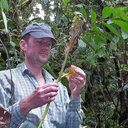Intraspecific phytochemical variation shapes community and population structure for specialist caterpillars.
Кључне речи
Апстрактан
Chemically mediated plant-herbivore interactions contribute to the diversity of terrestrial communities and the diversification of plants and insects. While our understanding of the processes affecting community structure and evolutionary diversification has grown, few studies have investigated how trait variation shapes genetic and species diversity simultaneously in a tropical ecosystem. We investigated secondary metabolite variation among subpopulations of a single plant species, Piper kelleyi (Piperaceae), using high-performance liquid chromatography (HPLC), to understand associations between plant phytochemistry and host-specialized caterpillars in the genus Eois (Geometridae: Larentiinae) and associated parasitoid wasps and flies. In addition, we used a genotyping-by-sequencing approach to examine the genetic structure of one abundant caterpillar species, Eois encina, in relation to host phytochemical variation. We found substantive concentration differences among three major secondary metabolites, and these differences in chemistry predicted caterpillar and parasitoid community structure among host plant populations. Furthermore, E. encina populations located at high elevations were genetically different from other populations. They fed on plants containing high concentrations of prenylated benzoic acid. Thus, phytochemistry potentially shapes caterpillar and wasp community composition and geographic variation in species interactions, both of which can contribute to diversification of plants and insects.


